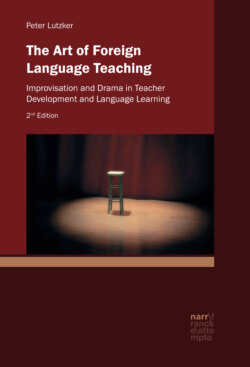Читать книгу The Art of Foreign Language Teaching - Peter Lutzker - Страница 11
1.2 The Model of Teaching as an Art
ОглавлениеConsidering teaching as an art implies not only a different understanding, but requires adopting a different framework of knowledge as well. In the arts there are clearly ways of knowing that cannot be represented within the measurable, objective domains of traditional science and education. The musician’s sensitivity to nuances of tone, the actor’s to voice and gesture, the clown’s to the possibilities of improvisation, all represent forms of knowledge and expression which do not lend themselves easily to rational, scientific discourse. Nor do they represent that type of knowledge which most educational research and theory has propagated as essential in teacher education, or, for that matter, for pupils in their schooling. At the same time they are all, incontrovertibly, examples of highly precise and expressive ways of knowing and acting.
The framework which will be examined in the following chapters is based on a view of teaching in which such forms of artistic knowledge are considered to be highly relevant in teaching and thus essential elements in teacher education. Intrinsic to this standpoint is the belief that teaching demands sensitivities and skills which are far closer to those required of artists, than those of scientists. Although this approach does not reflect most contemporary educational thinking, there have been educators who have adopted similar positions. The most prominent of these has been Elliot Eisner. In a chapter called ‘On the Art of Teaching’ in his seminal book The Educational Imagination (1985) he explains the four reasons which lead him to define teaching as an art:
First, it is an art in the sense that teaching can be performed with such skill and grace that, for the student as for the teacher, the experience can be justifiably characterized as aesthetic. (…)
Second, teaching, is an art in the sense that teachers, like painters, composers, actresses, and dancers, make judgments based on qualities that unfold during the course of action. (…)
Third, teaching is an art in the sense that the teacher’s activity is not dominated by prescriptions or routines but is influenced by qualities and contingencies that are unpredicted. (…)
Fourth, teaching is an art in the sense that the ends it achieves are often created in process. (…)
It is in these four senses – teaching as a source of aesthetic experience, as dependent on the perception and control of qualities, as a heuristic, or adventitious activity, and as seeking emergent ends – that teaching can be regarded as an art.27
In the context of this study, the last three reasons which Eisner has presented will become the focus of attention. They address different, but related aspects of the process of teaching itself, emphasizing its dynamic and indeterminate qualities. In contrast to his initial point in which he adopts the more distanced perspective of appreciating the aesthetic/artistic qualities of excellent teaching, his last three points are focused on the internal and creative processes occurring during the act of teaching. Using terms like “flexible purposing” and “fluid intelligence,” he elucidates how artists learn to address changing elements in their mediums, drawing on a repertoire of possibilities to create and work with those dynamic qualities intrinsic to their respective art forms.28 In establishing parallels between such processes in the arts and in teaching, a framework is created in which the paradigms of the arts become attainable for teachers through realizing possibilities within their own medium. The teacher as artist is thus seen as exhibiting comparable forms of skill and grace as the musician, dancer, or actor. Such highly individual, dynamic processes in which unique qualities of artistry become most visible, contrast most strongly with the mechanistic following of predefined recipes and routines.
This vision of teaching clearly raises a host of significant issues and questions in regard to teacher education. In the context of viewing teaching as an art, an alternative to traditional pre-service and in-service education is clearly called for. However, within the settings and frameworks in which such training customarily takes place, this has, unsurprisingly, proved to be extremely difficult to institute. Hence for Eisner and others who have argued in a similar vein, the daunting challenges implied in developing new forms of teacher education have consistently emerged as a central and intransigent problem.29 The first part of this study will focus on addressing this problem both conceptually and in the context of empirical research.
In examining the concept of teaching as an art and the resulting implications for teacher education today, it will first be helpful to consider critical issues within a much larger historical framework. It was most notably in Classical Greece, in the period of German Idealism and later in the reform movements at the beginning of the 20th century that the connections between teaching and the arts were viewed as a central dimension of educational thinking. Many of the questions and problems which were widely discussed in those times bear strong similarities to issues which Eisner and others have raised today. Thus, to gain a broader understanding of the origins and development of this concept, as well as to incorporate previous thinking and experiences into present considerations, it can be highly instructive to trace the historical origins of this view in both the European and Anglo-American educational traditions. Adopting an historical perspective is thus seen as a prerequisite to understanding how this concept evolved into its present form and also as potentially relevant and illuminating in a contemporary context.
